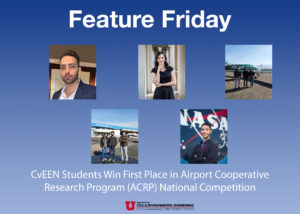 CvEEN Students were awarded first place in The Transportation Research Board’s Airport Cooperative Research Program at the University Design Competition for Addressing Airport Needs.
CvEEN Students were awarded first place in The Transportation Research Board’s Airport Cooperative Research Program at the University Design Competition for Addressing Airport Needs.
Read the press release below for further details.
"Winners Selected for the 2020-2021 TRB Airport Cooperative Research Program University Design Competition for Addressing Airport Needs
June 24, 2021
WASHINGTON — The Transportation Research Board’s Airport Cooperative Research Program (ACRP) has selected winners for its annual University Design Competition for Addressing Airport Needs. Now in its 15th year, the prestigious competition encourages students to design innovative and practical solutions to challenges at airports. Five first-place winners were chosen across four technical challenge areas: Airport Environmental Interactions, Airport Operation and Maintenance, Runway Safety/Runway Incursions/Runway Excursions, and Airport Management and Planning.
Airport Environmental Interactions Challenge:
A team of graduate students from the College of Aeronautics at Florida Institute and Technology won first place for its proposal titled FlyKey. The students proposed a design that focuses on the implementation of technology to make the experience for the traveler convenient and safe. Faculty adviser: Deborah Carstens.
Airport Operation and Maintenance Challenge:
A team of undergraduate and graduate students from San Jose State University’s Aviation and Technology Department won first place for its proposal titled Conceptual Design of Vertiport and UAM Corridor. The team proposed a schematic design of a vertiport with a surface footprint of 340 ft² to increase consumer benefits by increasing accessibility and operational efficiency of the vertiport. Faculty adviser: Wenbin Wei.
Runway Safety/Runway Incursions/Runway Excursions Challenge:
A team of undergraduate students from Michigan Technological University’s Civil and Environmental Engineering Department captured first place for its proposal titled Graphical NOTAM Interface for Improving Efficiency of Reporting NOTAM Information. The team developed an Electronic Flight Bag user interface that provides a graphical representation of a notice to airmen (NOTAM) and weather information to improve how pilots receive condition changes at airports. Faculty adviser: Audra Morse.
Airport Management and Planning Challenge:
An undergraduate team from the Civil and Environmental Engineering Department at the University of California, Berkeley, tied for first place for its proposal titled High Occupancy Vehicle (HOV) Traffic Management Concept on Airfields: Increasing Airport Capacity and Reducing Passenger Delay. The design proposal offered outside-of-the-box thinking to help solve the issue of airfield congestion utilizing HOV methods. Faculty adviser: Jasenka Rakas.
The second first-place winner was a team of undergraduate and graduate students from the University of Utah’s Civil and Environmental Engineering Department for its proposal titled Automatic Independent Video-based Air Traffic Surveillance System (AIVATS). The students presented a much needed and innovative design for an automatic system that would monitor air traffic at non-towered airports. Faculty adviser: Abbas Rashidi.
In addition, teams from Pennsylvania State University and Michigan Technological University won second-place awards, a team from Purdue University won a third-place award, and teams from Purdue University, Florida Institute of Technology, and Pennsylvania State University received honorable mentions.
Students were invited to propose innovations in any of the four technical challenge areas. The competition requires that students work with a faculty adviser and that they reach out to airport operators and industry experts to give advice and assess the practicality of their proposed design solutions. The Virginia Space Grant Consortium of Hampton, Virginia, manages the competition on behalf of the ACRP. Funding for the competition is provided by the Federal Aviation Administration.
Volunteer panels of airport industry and academic practitioners as well as FAA representatives selected the winning submissions from among the proposals submitted by 63 student teams. First-place winners will receive their awards and present their work at a virtual awards ceremony on Aug. 4. The students will also present their designs at the virtual Airport Consultant Council’s Airport Technical Workshop as a keynote presentation. In addition, they will be given the opportunity to present their winning proposal at an industry professional conference or workshop in fall 2021. Winning teams receive $3,000 for first place, $2,000 for second place, $1,000 for third place, and $500 for honorable mentions.
The names of all winners and copies of designs receiving place awards are available at the https://vsgc.odu.edu/acrpdesigncompetition/2021-competition-winners-3/.
New guidelines for the 2021-2022 academic year competition will be available on the competition website by Aug. 1, 2021.
The Airport Cooperative Research Program (ACRP) is an industry-driven, applied research program that develops near-term, practical solutions to airport challenges. The program is managed by the Transportation Research Board (TRB), which is a program unit of the National Academies of Sciences, Engineering, and Medicine — private, nonprofit institutions that provide independent, objective analysis and advice to the nation to solve complex problems and inform public policy decisions related to science, technology, and medicine. The National Academies operate under an 1863 congressional charter to the National Academy of Sciences, signed by President Lincoln. For more information, visit http://national-academies.org.
Follow us:
Twitter @NASEMTRB
Facebook @NASEMTRB
Contact:
Andrew Robinson, Media Relations Associate
Office of News & Public Information
202-334-2138; e-mail news@nas.edu"

 CvEEN Students were awarded first place in The Transportation Research Board’s Airport Cooperative Research Program at the University Design Competition for Addressing Airport Needs.
CvEEN Students were awarded first place in The Transportation Research Board’s Airport Cooperative Research Program at the University Design Competition for Addressing Airport Needs. The computers now run the Red Hat Enterprise Linux 8 operating system, allowing students to use the latest software, said Linux Systems Administrator Zane Zak.
The computers now run the Red Hat Enterprise Linux 8 operating system, allowing students to use the latest software, said Linux Systems Administrator Zane Zak.